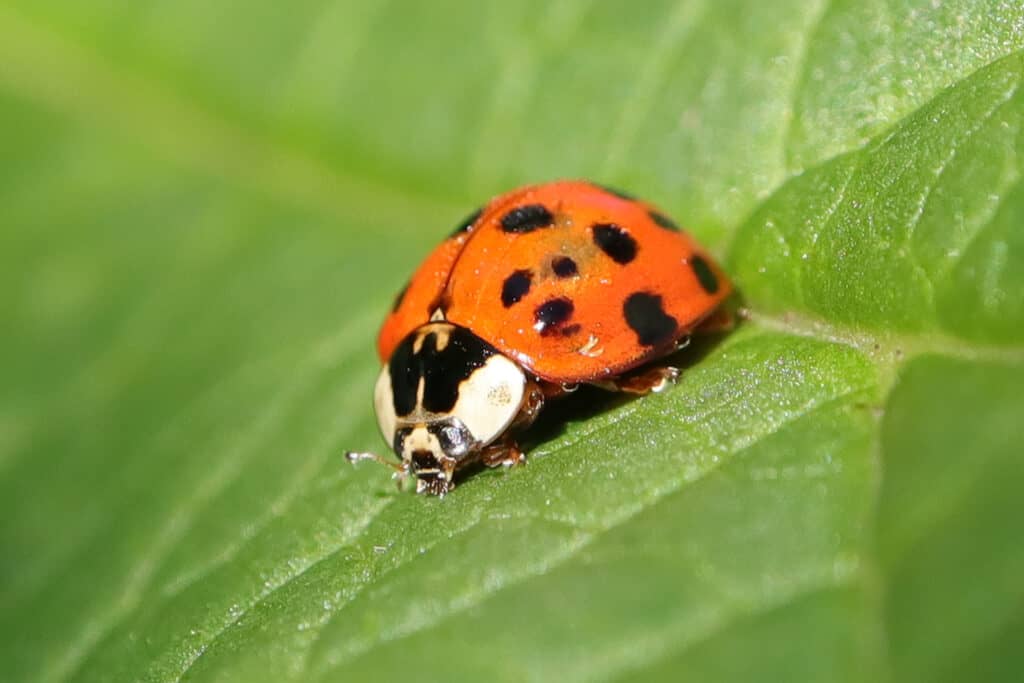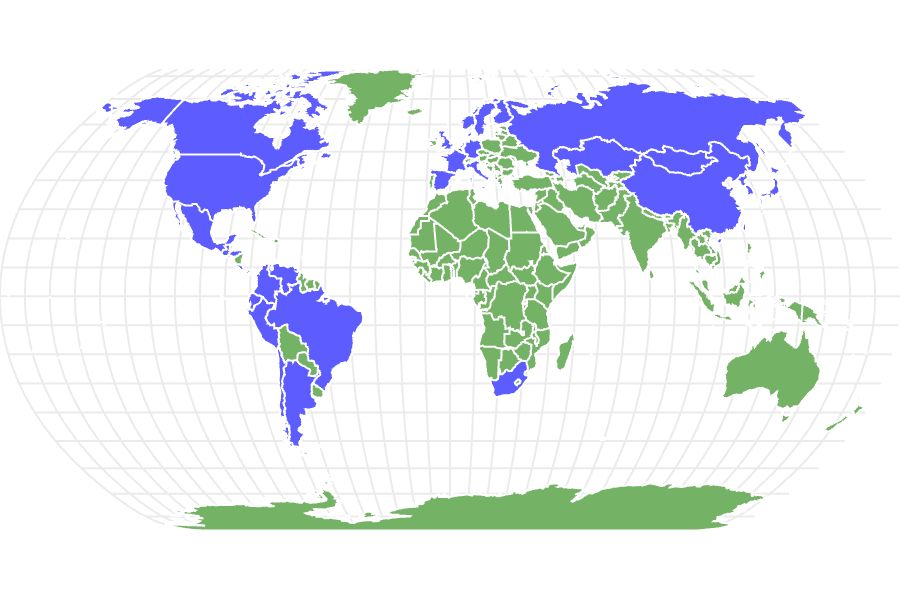Asian Lady Beetle
Harmonia axyridis
Asian lady beetles infest indoor spaces, but they do not reproduce indoors.
Advertisement
Asian Lady Beetle Scientific Classification
- Kingdom
- Animalia
- Phylum
- Arthropoda
- Class
- Insecta
- Order
- Coleoptera
- Family
- Coccinellidae
- Genus
- Harmonia
- Scientific Name
- Harmonia axyridis
Read our Complete Guide to Classification of Animals.
Asian Lady Beetle Conservation Status
Asian Lady Beetle Facts
- Prey
- Aphids, plant scale and other soft-bodied insects
- Main Prey
- Aphids
- Name Of Young
- larva
- Group Behavior
- Infestation
- Fun Fact
- Asian lady beetles infest indoor spaces, but they do not reproduce indoors.
- Distinctive Feature
- There's a white "M"-shaped marking on the black section behind the bug's head
- Other Name(s)
- harlequin, multicolored Asian, pumpkin ladybird
- Habitat
- Primarily found in forests and orchards
- Predators
- Wasps, spiders, lizards, toads and birds
- Diet
- Insectivore
View all of the Asian Lady Beetle images!
Asian Lady Beetles infest indoor spaces, but they do not reproduce indoors.
Summary
The Asian Lady Beetle is a large beetle in the coccinellid family (ladybug family). The beetle is native to Eastern Asia but was introduced to North America and Europe in the 1900s. Like other ladybugs, gardeners consider the Asian Lady Beetle a beneficial insect because it feeds on aphids, mealybugs, spider mites, and other insects that destroy garden plants. However, Asian Lady Beetles can be problematic when they get into homes. They emit a foul-smelling secretion that can stain walls and furniture. Asian Lady Beetles also bite humans and pets, which makes an infestation quite annoying.
Asian Lady Beetle Species, Types, and Scientific Name
The Asian Lady Beetle (Harmonia axyridis) has many nicknames. It is also referred to as the harlequin, multicolored Asian, pumpkin ladybird, and so on. This large beetle is a typical coccinellid. This means it belongs to a family of beetles known as ladybugs or ladybirds. There are more than 6,000 species of beetles in this family, and the majority are considered beneficial insects because they feed on insects that are considered plant pests, such as aphids and scale insects. A round or elliptical dome-shaped body characterizes coccinellids. Like all beetles, they have a rigid wing cover. However, in the case of the ladybugs, the elytra typically bear unique markings, spots, or stripes. The specific markings tend to vary from one ladybug species to the other.
As their name suggests, Asian ladybugs are native to the Asian continent. Specifically, they originated from Eastern Asia. However, they were introduced artificially to other parts of the world and are now well-established in North America, South America, Europe, and Africa.
Appearance: How To Identify Asian Lady Beetle
The Asian Lady Beetle has a typical coccinellid beetle shape. This means it has an oval or convex domed body, with a smooth transition between the rigid wing cover (elytra), the pronotum (or thorax), and the head.
The Asian Lady Beetle is one of the most variable species of ladybugs in the world, making identification a little tricky. Members of this species occur in a wide range of color forms. Harmonia axyridis typically range between 5.5–8.5 mm in size.
While this insect has several color forms, the most common one is red or orange. It may have up to 22 black spots of variable sizes or not black spots at all. This is known as f. “succinea,” Other common color forms include f. “conspicua” and f. “spectabilis.” These have uniformly black markings with two or four red markings. Their pronotum is typically white, while their underside is dark with a reddish-brown border.
Regarding color and patterns, Asian Lady Beetles look just like traditional ladybugs. However, they have a distinct marking that makes it easy to differentiate between these two beetles. Just behind the Asian Lady Bug’s head, there’s a white “M” or “W” shaped marking, which confirms that you’re dealing with an Asian Lady Beetle.
Asian Ladybugs are mostly found outdoors. However, they may fly into buildings in search of spots to overwinter. When they end up inside buildings, they often end up crawling on windows and walls, emitting a bad-smelling yellowish fluid that stains surfaces and furniture.

While Asian Lady Beetles look like ladybugs, the white marking behind its head denotes its status.
©iStock.com/DE1967
Habitat: Where To Find Asian Lady Beetle
Harmonia axyridis is native to Asia and abundant in Central to Eastern Asia. However, given its status as a ferocious predator that feeds on insects like Aphids and scale insects, the Asian Ladybug was introduced to other continents. The species is now well established in North America, South America, Europe, and some parts of Africa.
In their native locations, the Asian Lady Beetle is a tree-dwelling insect. They live primarily in forests and orchards. However, in some places, such as in Japan, they’re quite abundant in soybean farms. In North America and Europe, this beetle is most commonly found in ornamental and agricultural gardens in association with plants like corn, soybeans, roses, tobacco, alfalfa, and so on.
Outside its native land, the Asian Ladybug has become quite established and is now considered one of the most invasive insect species in many regions of the world. They tend to infest indoor spaces in search of crevices and protected areas where they can spend the winter. When this happens, the naturally beneficial insect becomes a terrible household pest because they release foul-smelling fluid and may bite humans and pets. Asian Lady Beetles are also out-competing many native species due to their voracious appetite and resistance to diseases that affect other ladybugs.
Diet: What Do Asian Lady Beetles Eat?
Like all ladybugs, Asian Lady Beetles eat aphids and other soft-bodied insects. Due to their ability to eat insects that typically damage agricultural crops, farmers and gardeners consider Asian ladybugs as beneficial insects.
What Eats Asian Lady Beetles?
Asian Lady Beetles don’t have a lot of natural enemies. Wasps and some flies may parasitize them. In some regions, they may also suffer fungal infections, but this is rarely lethal. This insect has a potent defense against predators like toads, lizards, spined soldier bugs, and ants. When disturbed, they’re known to secrete a foul-smelling and bitter-tasting fluid from their leg joints.
Prevention: How To Get Rid of Asian Lady Beetles
The best way to handle Asian Lady Beetles is to prevent them from getting indoors in the first place. You can ensure this by sealing your windows, door screens, chimneys, vents, and sidings. Sealing any entry point through which they enter your home will keep them from infesting your building.
If they do get inside, vacuuming them is the best way to get rid of them. Alternatively, you can use a broom to sweep the beetles. This will prevent them from emitting the bad-smelling secretion.
While insecticides can kill ladybugs, we do not recommend this approach. Insecticides are often ineffective and may leave unwanted stains and residue on walls and other surfaces in your home. Consider inviting pest control professionals as soon as you notice an infestation.
Related Insects:
View all 194 animals that start with AAsian Lady Beetle FAQs (Frequently Asked Questions)
Should I get rid of Asian lady beetles?
In gardens and outdoor spaces, Asian Lady Beetles are beneficial. They feed on herbivorous insects like aphids and scale insects, making them an effective biological control against these insects. However, in indoor spaces, they may not be so beneficial. They release a foul-smelling yellowish liquid that stains walls. Some people are also allergic to this secretion, and the fact that they congregate in large numbers can be annoying.
What is the difference between a ladybug and an Asian beetle?
Ladybugs have a bright red coloration with black spots on their wings. The color of Asian lady beetles often varies from red to orange. Also, the black spots on the wing covers of Asian Lady beetles may be absent in some varieties. However, the most distinct feature that differentiates these two bugs is the presence of an “M” shaped marking just under the head of the Asian lady beetle.
Do ladybugs lay eggs in houses?
Although they often infest indoor spaces, Asian lady beetles don’t lay eggs in buildings. They only use indoor spaces as an overwinter hibernation spot. They’ll leave during the following spring season.
Thank you for reading! Have some feedback for us? Contact the AZ Animals editorial team.
Sources
- University of Kentucky, Available here: https://entomology.ca.uky.edu/ef416
- Wikipedia, Available here: https://en.wikipedia.org/wiki/Harmonia_axyridis
- Wikipedia, Available here: https://en.wikipedia.org/wiki/Coccinellidae
- House Beautiful, Available here: https://www.housebeautiful.com/lifestyle/gardening/a27244331/asian-lady-beetle-vs-ladybug/

















